Browse Exhibits (89 total)
Understanding numbers

1954, 7 programs, University of Michigan Television
From WNET:
"This series is aimed at developing a better general understanding among viewers of basic mathematical principles. It is presented in a simple, straightforward style with the help of charts and other illustrative devices. This tele-course offers students an increasing understanding of numbers as well as some of the fun and fascination which numbers have provided for many persons from pre-historic times. The series was produced by the University of Michigan Television Department."
Uncle Wonder's Workshop
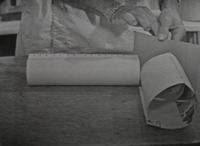
1958, 26 episodes, WCET (Cincinnati)
From WNET:
"Uncle Wonder makes the principles of the sciences simple for the pre-school child. Glenn Ryle, as Uncle Wonder, participates with children in their own world to help them discover some of the “truths” of the world. The series emphasizes power and includes simple demonstrates of natural phenomena such as gravity, sound, light, etc. Uncle Wonder operates in a three-part workshop: workbench for woodworking and demonstrating; nursery section for planting and plant demonstrations; and a laboratory setting for work with water, chemicals, and other liquids. Uncle Wonder makes the principles of the sciences simple for the pre-school child. He uses domestic objects, such as a milk bottle or a bar of soap, to illustrate how rain is formed or how surface tension works. Many of his TV experiments can be duplicated in the home with materials normally at hand. Uncle Wonder in each program invites his viewers into his workshop where he answers many of the questions of wonderment that fill the minds of little folk."
Sing Hi, Sing Lo
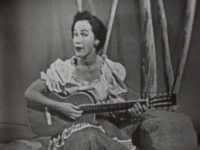
104 episodes, 1958-1959, KQED (San Francisco)
From WNET:
"'Sing Hi – Sing Lo' presents for youngsters the folklore of America through folk dances and folk song. Each program concentrates on one subject; some of the programs include appropriate film clips to better illustrate the material. The folk songs (sing by Bash Kennett who accompanies herself on her guitar) are tied in with the narration; while many of the songs are familiar to the children of America, some of them are lesser known and are truly descriptive of times past. A group of young dancers performs some of the songs. Through “Sing Hi – Sing Lo,” children will learn about people, events and customs which are a part of American history. They will better know their own country and understand the purposes, traditions and activities of their land. The series was produced by KQED, San Francisco, with Kay Rawlings as producer."
The Written Word
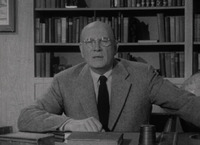
15 episodes, 1957, Department of Cinema, University of Southern California
From WNET:
"This long-awaited series featuring Dr. Frank Barter tells the story of human records from primitive marks and pictographs to the coming of modern machine methods of printing after 1800. Using pictures, charts, maps, blackboard, and many models and demonstrations, the program tells the story of our alphabet from its Proto-Semitic beginnings to important families of modern typefaces. Attention is given to cuneiform writing and to the many varieties of writing of the Egyptians. The basic writing substances of the western world (clay, papyrus, parchment and paper) are all discussed and actual demonstrations show the making of a clay brick and the manufacture of sheets of papyrus and paper. Dr. Baxter demonstrates the art of block printing, and on a model of an early press prints a small four-page folio book. Most of the models, drawings, and visual materials used on these programs are the work of the lecturer. Original manuscript and printed leaves and books are displayed and commented on. Dr. Baxter feels that this brief series constitutes an interesting introduction to the history of the written and printed word. A bibliography prepared by Dr. Baxter will be available for distribution."
Tension areas
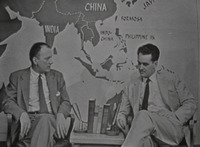
6 episodes, 1955, University of Michigan
From WNET:
"This is a series of discussions of vital "tension areas" in the Far East and their importance to the United States. Appearing as guest on each program is Albert Ravenholt, correspondent of the American Universities Field Staff and staff correspondent for the Chicago Daily News. Mr. Ravenholt is considered one of the nation's best-informed men on the Far East. Moderator for the programs is Dr. George A. Peek, Jr., assistant professor of political science at the University of Michigan. Other participants include Dr. John W. Hall, assistant professor of history and acting director of the Center for Japanese Studies; Dr. John W. Lederle, professor of political science and comptroller of the State of Michigan; Dr. Charles M. Davis, professor of geography; and Dr. Theodore M. Newcomb, professor of sociology and chairman of the doctoral program in social psychology, all at the University of Michigan. Important problems discussed are: Formosa, Hong Kong, the Philippine Republic, The Impact of U. S. Military Aid in the Far East, Chinese Minorities in Southeast Asia, and the Challenge of Rural Asia."
The Secret of Flight
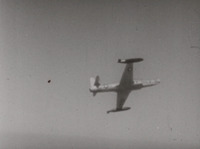
1959, 13 episodes, State University of Iowa
From WNET:
"'The Secret of Flight' is a lecture series about the basic problems of flight, explained by visual presentation of flow experiments. As the material of the lectures should be understood by every interested listener, no mathematical or other theoretical knowledge is used for explanation. Every problem is demonstrated by a true-life experiment and purely scientific language is avoided. Each of the lectures deals with a basic problem of flight. The experiments are mostly shown as flow picture but at certain points scale models and flying models are used to ensure easier understanding. As an average there are about eight different experiments in a half hour lecture at the end of each presentation. The lecture series is divided into two main divisions. Lectures one through seven explain the basic problems which lead to the invention of the airplanes. Lectures eight through 13 point out the more modern problems of aerodynamics and explain some subjects of general interest which ae connected with flight and fluid motion. The series was produced by the State University of Iowa and directed by Sam Becker, head of SUI’s television department."
Japanese Brush Painting

13 programs, 1958, KQED (San Francisco)
From WNET:
"In this series, artist T. Mikami illustrates the artistry of “Japanese Brush Painting.” Makami, who claims that everyone is a potential artist, intends to prove this during his 13 classes. Kits are available and viewers can paint along with the outstanding artist."
Prelude to the Presidency
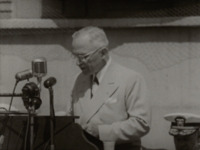
7 episodes, 1956, WQED (Pittsburgh)
From WNET:
"This seven program series, originating from station WQED, features top men in the political field in an overall depth study of American political procedures leading up to election of a president. A major portion of the first six programs are documentary in nature, employing narration and film clips from the National Broadcasting Company film Library in New York. Research materials for the series were prepared by Dr. William Keefe of Chatham College and Dr. Edward Cooke of the University of Pittsburgh. Dr. Albert B. Martin, director of the Citizenship Clearing House of Western Pennsylvania, serves as host for the series. Filmed interviews feature seven US Senators: Henry Cabot Lodge; James Farley, former national chairman of the Democratic Party; Mayor David L. Lawrence of Pittsburgh; and Dr. Elmer Schattsneider, head of the American Political Science Association. This series was financed by a grant from the Falk Foundation and the project was coordinated through the Citizenship Clearing House of Western Pennsylvania."
Psychology One

37 episodes, 1957, WGBH (Boston)
From WNET:
"The purpose of “Psychology One” is to show anyone who is interested how man – any human being – works. The course, an adaptation of the course Professor Edwin J. Boring has given at Harvard for thirty-two years, will discuss human thought and conduct as a function of their causes: the scientific and biological view of man as a part of the nature world – why he is the way he is. So Professor Boring starts out with a discussion of the nervous system and of reaction to stimulation. When he shoots off his revolver even the TV audience is going to jump because that reaction is already built into their nervous systems. He will talk about instinctive reaction, about motivated reaction, then about how people learn new reactions and how they change the old ones, and then about they perceive the outside world by use of the five senses, and finally about their abilities and personalities – how people differ from one another, how they grow up, how they adjust to one another and to the difficulties of living. Whenever possible, the TV audience will become the subjects in Professor Boring’s demonstrations. On the TV screen they can see many of the perceptual phenomena that he talks about – illusions, after-images, the way the size of objects seem to vary with their distance. In one sense, man is seen as a complex machine – in another sense, he is free to choose what he will do. But the main thing is to find out how a human being works, and why. Produced by WGBH-TV, Boston, “Psychology One” was produced and directed by Thomas K. Sissow."
Eastern Wisdom and Modern Life
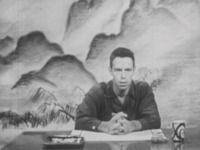
13 episodes, 1959, KQED (San Francisco)
From WNET:
"This series of programs deals with the themes of Eastern philosophy and their application to modern life. The programs are illustrated by Chinese and Japanese paintings and other Asian objects of art. Photographs and physical demonstrations of various principles and processes are also incorporated in the presentation. Host Alan Watts uses Chinese ink and rush for drawings and diagrams he executes during the series."

